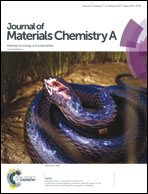Judicious engineering of a metal-free perylene dye for high-efficiency dye sensitized solar cells: the control of excited state and charge carrier dynamics†
Abstract
Molecular engineering of a photosensitizing dye plays a vital role in the control of excited states and charge carriers in dye-sensitized solar cells (DSCs) for performance improvement. Herein we report three metal-free donor–acceptor organic dyes by conjugating electron donors triphenylamine–cyclopentadithiophene (TPA–CPDT), triphenylamine–phenanthrocarbazole (TPA–PC), and di(biphenyl)amine–phenanthrocarbazole (DBPA–PC) with electron acceptor 4-(7-ethynylbenzo[c][1,2,5]thiadiazol-4-yl)benzoic acid (EBTBA). The influences of electron donors on the energy levels, light absorption, dynamics of excited states and photogenerated charges, and photovoltaic parameters of DSCs were systematically analyzed via theoretical calculations and physical measurements. A DSC with dye SC-3 employing the bulky DBPA–PC electron donor achieved a high power conversion efficiency (PCE) of 11.5% measured under the air mass 1.5 global (AM1.5G) conditions, owing to the significantly reduced interfacial charge recombination. Femtosecond fluorescence upconversion measurements have unraveled that energy relaxation and electron injection both occur for dye molecules in the nonrelaxed hot excited states. Also, the rate constants of injecting electrons from dyes in the excited states to titania are very dispersive by over 1 order of magnitude, which could be mainly ascribed to the broad energy distribution of excited states.



 Please wait while we load your content...
Please wait while we load your content...